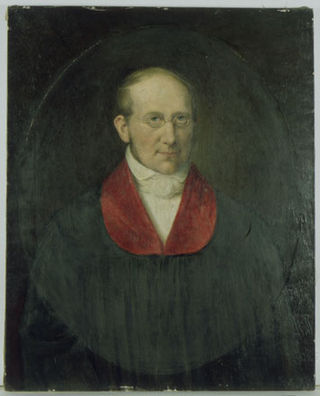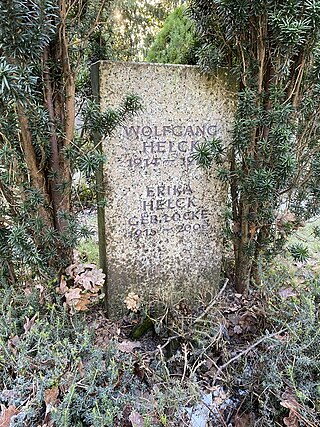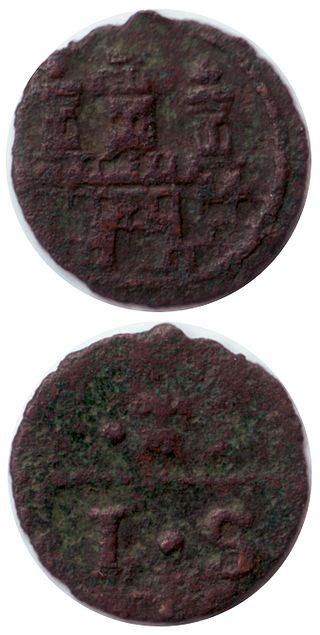
The Heller, abbreviation hlr, was a coin, originally valued at half a pfennig, that was issued in Switzerland and states of the Holy Roman Empire, surviving in some European countries until the 20th century.

Liudolf, a member of the Ottonian dynasty, was Duke of Swabia from 950 until 954. His rebellion in 953/54 led to a major crisis of the rising German kingdom.

Blaubeuren Abbey was a Benedictine monastery until the Reformation, located in Blaubeuren, Baden-Württemberg, Germany. It is now a Protestant seminary.

Saint Sigfrid of Sweden (Swedish: Sigfrid, Latin: Sigafridus, Old Norse: Sigurðr, Old English: Sigefrið/Sigeferð) was a missionary-bishop in Scandinavia during the first half of the 11th century. Originally from England, Saint Sigfrid is credited in late medieval king-lists and hagiography with performing the baptism of the first monarch of Sweden, Olof Skötkonung. He most likely arrived in Sweden soon after the year 1000 and conducted extensive missions in Götaland and Svealand. For some years after 1014, following his return to England, Sigfrid was based in Trondheim, Norway. However, his position there became untenable after the defeat of Olaf Haraldsson.

Hermann Friedrich Stannius was a German anatomist, physiologist and entomologist. He specialised in the insect order Diptera especially the family Dolichopodidae.

Otto Max Johannes Jaekel was a German paleontologist and geologist.

Hans Wolfgang Helck was a German Egyptologist, considered one of the most important Egyptologists of the 20th century. From 1956 until his retirement in 1979 he was a professor at the University of Hamburg. He remained active after his retirement and together with Wolfhart Westendorf published the German Lexikon der Ägyptologie, completed in 1992. He published many books and articles on the history of Egyptian and Near Eastern culture. He was a member of the German Archaeological Institute and a corresponding member of the Göttingen Academy of Sciences.

Hans Lipps was a German phenomenological and existentialist philosopher.

Kriebstein Castle is a castle in Kriebstein near the town of Waldheim in the German state of Saxony.

The Cross of Mathilde is an Ottonian processional cross in the crux gemmata style which has been in Essen in Germany since it was made in the 11th century. It is named after Abbess Mathilde who is depicted as the donor on a cloisonné enamel plaque on the cross's stem. It was made between about 1000, when Mathilde was abbess, and 1058, when Abbess Theophanu died; both were princesses of the Ottonian dynasty. It may have been completed in stages, and the corpus, the body of the crucified Christ, may be a still later replacement. The cross, which is also called the "second cross of Mathilde", forms part of a group along with the Cross of Otto and Mathilde or "first cross of Mathilde" from late in the preceding century, a third cross, sometimes called the Senkschmelz Cross, and the Cross of Theophanu from her period as abbess. All were made for Essen Abbey, now Essen Cathedral, and are kept in Essen Cathedral Treasury, where this cross is inventory number 4.

The Royal Palace of Werla is located near Werlaburgdorf in Lower Saxony. The grounds of the royal palace cover about 20 hectares rising atop Kreuzberg hill, a 17 m high natural plateau overlooking the Oker river. In the Early Middle Ages the palace was an important place in the Holy Roman Empire, serving as an important base for the Ottonians in the 10th century in particular. Although it subsequently lost its political significance to the newly established Imperial Palace of Goslar at Rammelsberg, it developed into an independent settlement with a busy industrial quarter. In the 14th century it fell into ruin and was completely unknown until its rediscovery in the 18th century. The core fortress in particular was thoroughly excavated in the 20th century. Excavations carried out since 2007 have brought new understanding to the hitherto largely unexplored outworks. Since 2010 the palace complex with foundation and enceinte, as well as earthworks, has been partially reconstructed and is now open to the public as the Archäologie- und Landschaftspark Kaiserpfalz Werla.

Vera von Falkenhausen is a German Byzantinist who lives and works in Italy.
Brita Ingrid Maria Malmer, was a Swedish numismatist who specialized in the Viking Age. She was Sweden's first professor of numismatics.
Ludwig Holtmeier is a German music theorist and piano player.
Tall Bazi, is an ancient Near East archaeological site in Raqqa Governorate of Syria in the same general area as Mari and Ebla. It is located on the Euphrates river in upper Syria, about 60 kilometers south of Turkey near the abandoned town of Tall Banat. Tall Bazi has been proposed as the location of Armanum, known from texts of the Akkadian period, during the reign of Naram-Sin of Akkad. It was occupied into the Mitanni period at which time it was destroyed. In the late Roman Empire a large building was constructed at the top of the main mound.

The history of Saxon coinage or Meissen-Saxon coinage comprises three major periods: the high medieval regional pfennig period, the late medieval pfennig period and the thaler period, which ended with the introduction of the mark in 1871/72. Rich silver deposits, which were discovered near Freiberg after the middle of the 12th century, helped Saxony to a leading position in German coinage.
The regional pfennig was a type of pfennig, a low denomination coin used in the Holy Roman Empire that began to appear in the 10th century after the period of the supra-regional pfennigs following the coin reform of the Emperor Charlemagne of Francia. With the increasing allocation of royal minting rights under the Münzregal to other mints, different types of pfennig emerged. The mints with their own minting rights included those cities that had attained a special degree of independence, in some cases even imperial immediacy. However, a localization of coinage was partly counteracted by a move by cities to form minting associations or Münzvereins, in which minting agreement standards for the weight and, above all, the fineness of coins were set. which must not be undercut in order to ensure unrestricted convertibility of the coins within the contract area. In later centuries, larger denominations of higher value were introduced, such as the groschen (grossus) and, in the Alpine region, the Kreuzer. The pfennig thus fell from being a major coin and currency money to a small Scheidemünze coin. Attempts at standardisation concentrated on the new, larger denominations and no longer on the pfennig, which basically remained a state coin of only regional significance. In Germany, the pfennig was only successfully unified again in the 19th century, initially through the Prussian small coinage reform of 1821 for the various small coins in the Prussian provinces, and then through the second Imperial Coin Act of 1873.

The Sachsenpfennig, sometimes called the Wendenpfennig or the Hochrandpfennig was a well-known coin of the pfennig type minted in the eastern part of the Stem Duchy of Saxony during the 10th and 11th centuries. It had an upturned perimeter and, next to the Otto Adelheid Pfennig was the most common pfennig type of its time. Sachsenpfennigs are the oldest coins minted in Saxony. Its different names represent a lack of clarity within mediaeval numismatics about the coin.

A Scherf was a low-value silver coin used in Erfurt and other cities of the Holy Roman Empire from the Middle Ages to the 18th century. The name was later also given to a copper coin with a value of about half a pfennig. The simple scherf was only rarely minted; coins of 3, 6 and 12 scherf were more common, most recently in 1777 in Lüneburg.

The Ewiger Pfennig or eternal penny was a coin of the regional pfennig period, which was minted until the late medieval groschen time. These coins are mostly of the Hohlpfennig or "hollow pfennig" type which, unlike bracteates, had to be exchanged regularly for a fee but were not subject to annual recall of coins in circulation, the Münzverruf.


















